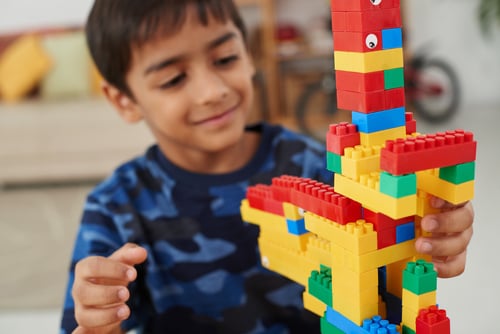Activity
Design Challenge: Gumdrop Towers
Spark your child’s creativity with this engaging design challenge. In this activity, your child will build a tower using gumdrops (or another soft material such as marshmallows or modeling clay) and toothpicks. The goal is to build a tower that is as tall as possible.
We have included step-by-step instructions as guidelines for the design thinking framework. Your job is to help your child through the design thinking process by teaching them the importance of empathy, brainstorming, and prototyping. This activity is aligned to the following NGSS: K-2-ETS1-1, K-2-ETS1-2, K-2-ETS1-3.
Grade
Subject
Thank you for your input.
What You Need
- Gumdrops (or any other soft material like fruit snacks, marshmallows, modeling clay, etc.)
- Toothpicks
- Ruler or tape measure
- Pen and paper for brainstorming and note-taking
- Optional: a small piece of cardboard (cut to fit at the top of the finished structure)
- Optional: at least 20 pennies (feel free to add more)
What You Do
- Give your child some gumdrops (or fruit snacks, marshmallows, or small balls of modeling clay) and toothpicks to start. Allow your child to explore the materials by asking them to build whatever they would like.
- After allowing your child to build freely for a while, ask them to take some notes on their creation. Ask your child to draw their design. Then, help your child measure and write down the height and width of the structure.
- Now, explain the design challenge to your child.
- Tell them their goal is to design a tower using gumdrop candies (or whatever material you provide) and toothpicks. The structure should be as tall as possible and be able to stand on its own without falling down.
- Ask your child to brainstorm ways in which they could change their current creation or build something completely new. For example, ask your child to build a structure that is narrower and taller.
- After your child has finished brainstorming, ask them to choose one of their ideas to build. Make sure to remind your child of the overall goal of their design.
- This is an important step of the design thinking process because it teaches your child to prioritize the functionality of their design over personal preferences, and it prevents them from getting too emotionally attached to one design.
- Now it is time for your child to actually build, or prototype, their design! Give your child room to test and create on their own, but help out if they need assistance.
- Once your child has finished building, help them to test their prototype.
- If their prototype stands on its own, congratulate them on their success!
- If your child’s design does not stand on its own, ask them what they think went wrong. Have your child go back to the original brainstorming and prototyping stages. Ask your child to redesign their structure and continue brainstorming and prototyping until their design is successful.
- Once your child has a tower that can stand on its own, consider one of the following activities:
- Measure the height of the tower and challenge them to make an even taller tower.
- Try placing a piece of cardboard on top of the tower and add pennies until the tower fails. Then, challenge your child to build a new design that can hold more pennies than their previous design.
- To finish the activity, ask your child a few final questions.
- What did they learn during the initial exploration of the materials?
- What different types of designs worked or did not work in each challenge?
- What was the most challenging part of the activity? What was the most fun part?
Related learning resources

STEM Design Challenge Cards
Worksheet
STEM Design Challenge Cards
These STEM design challenge cards ask learners to build something new for a specific reason or purpose and are a great way to foster creative thinking.
2nd grade
Science
Worksheet

Design Challenge: Creating a Cup Tower
Activity
Design Challenge: Creating a Cup Tower
...The purpose of this challenge is to teach your child design thinking strategies so that they can maximize their tower's height....
preschool
Science
Activity

Fill Three Towers
Worksheet
Fill Three Towers
Students will build familiarity with numbers within 30 as they race to fill three towers in this simple game.
1st grade
Math
Worksheet

Building Brick Challenge: Build a Tall Tower
Activity
Building Brick Challenge: Build a Tall Tower
The instructions include questions prompts to guide students through the design challenge.
1st grade
Science
Activity

STEM Design Challenge: Plan, Reflect, Revise
Worksheet
STEM Design Challenge: Plan, Reflect, Revise
Children will plan our their STEM design, reflect on the process of building their creation, and brainstorm ways they could make their design even better.
preschool
Science
Worksheet

Subtraction Towers
Lesson plan
Subtraction Towers
This lesson will help your students understand the relationship between addition and subtraction, as students build towers to find unknown addends.
1st grade
Math
Lesson plan

Design Challenge: Building a Bridge
Activity
Design Challenge: Building a Bridge
In this exciting and empowering challenge, your child will construct a bridge using marshmallows and toothpicks!
preschool
Science
Activity

Chair Design Challenge
Activity
Chair Design Challenge
...In this activity, your student will be presented with a unique design engineering challenge: Build a chair that is designed to meet the specific size and shape of a...
2nd grade
Science
Activity

Fill Three Towers
Lesson plan
Fill Three Towers
Students solidify an understanding of one-to-one correspondence as they compete to fill three towers. Use this EL Support Lesson alone, or alongside the lesson plan Counting Collections.
1st grade
Math
Lesson plan

STEM Design Challenge Cards for Young Learners
Worksheet
STEM Design Challenge Cards for Young Learners
Use these STEM design challenges to foster creativity and critical thinking skills in young learners while introducing them to the engineering process.
preschool
Science
Worksheet

STEM Design Challenge: Brainstorm and Reflection Sheet
Worksheet
STEM Design Challenge: Brainstorm and Reflection Sheet
Help children hone their creativity and critical thinking skills while providing hands-on experience with design planning, reflection, and writing process.
2nd grade
Reading & Writing
Worksheet

Design Challenge: Creating Animal Habitats
Activity
Design Challenge: Creating Animal Habitats
In this design thinking activity, your child will choose an animal to research, learn about the animal’s habitat, and then replicate the animal's habitat using household items.
2nd grade
Reading & Writing
Activity

